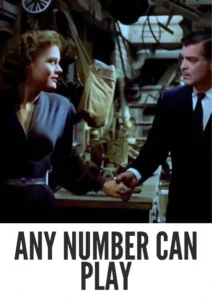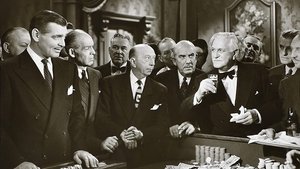Contact: info@alwanfilm.com
Video Sources 0 Views
- Watch trailer
- Any Number Can Play


Any Number Can Play 1949 Colorized
Synopsis
Table of Contents
ToggleReview: Any Number Can Play 1949 Colorized – A Captivating Drama Set in the Heart of the Casino

Introduction
“Any Number Can Play” (1949) is a compelling drama that delves into the world of high-stakes gambling and the complexities of human nature. In this review, we’ll explore the significance of this classic film and its enduring impact on audiences.
Check The Full Colorized Movies List
Check Our Colorized Movies Trailer Channel
Understanding Any Number Can Play 1949 Colorized: Director, Cast, and Genre
Directed by the talented Mervyn LeRoy, “Any Number Can Play” (1949) showcases his knack for crafting compelling narratives and eliciting powerful performances from his cast. The film features an ensemble cast led by the legendary Clark Gable, whose commanding presence anchors the story with gravitas and charisma. Blending elements of crime, drama, and romance, “Any Number Can Play” (1949) offers viewers a gripping glimpse into the high-stakes world of casino gambling.
Exploring the World of Any Number Can Play 1949 Colorized: Plot and Characters
“At its heart, “Any Number Can Play” (1949) follows the trials and tribulations of a seasoned gambler, portrayed by Clark Gable, who finds himself torn between his loyalty to his family and his passion for the game. As he navigates the treacherous waters of the casino world, he encounters a cast of colorful characters, each with their own motivations and desires. Through their interactions and conflicts, the film explores themes of love, betrayal, and redemption, offering viewers a poignant and thought-provoking narrative.
The Art of Film Colorization
Film colorization serves as a transformative tool that enhances the visual experience of classic movies, breathing new life into timeless stories and captivating audiences with vibrant hues. By digitally adding color to black and white films, colorization allows viewers to immerse themselves in the rich tapestry of cinematic worlds, exploring every nuance and detail with fresh eyes and renewed appreciation.
Early Colored Films: A Brief History
The history of colored films traces its roots back to the early days of cinema, with filmmakers experimenting with various techniques to add color to their creations. From hand-tinted frames to early Technicolor processes, the evolution of colored film has been marked by innovation and ingenuity, paving the way for the development of modern colorization techniques that continue to captivate audiences to this day.
Any Number Can Play 1949 and Its Early Colored Version
The decision to release “Any Number Can Play” (1949) in a colorized format was met with both excitement and trepidation. While some welcomed the opportunity to experience the film in vibrant color, others expressed concerns about the potential impact on its visual aesthetic. Nevertheless, the early colored version of “Any Number Can Play” (1949) offers viewers a fresh perspective on the timeless tale of love and redemption, enhancing its emotional resonance and captivating audiences with its luminous beauty.
The Debate Over Film Colorization
The debate over film colorization continues to divide audiences and critics alike, with proponents praising its ability to breathe new life into classic movies and introduce them to a new generation of viewers, while detractors argue that it compromises the artistic integrity of the original work and diminishes its historical significance. As the debate rages on, filmmakers and audiences alike are left to ponder the merits and drawbacks of colorization in the ever-evolving landscape of cinema.
Examining Any Number Can Play 1949 as an Early Colored Film
As with any colorized classic, the impact of colorization on “Any Number Can Play” (1949) is a matter of personal interpretation. Some may argue that it enhances the film’s visual appeal and immerses viewers in its world, while others may feel that it detracts from the stark beauty of the original black and white version. Regardless of one’s stance on the issue, there’s no denying the enduring power of “Any Number Can Play” (1949) as a timeless classic that continues to capture the hearts of audiences around the world.
Influence and Legacy: Any Number Can Play 1949’s Impact on Cinema
“Any Number Can Play” (1949) has left an indelible mark on the world of cinema, inspiring countless filmmakers and captivating audiences with its timeless tale of love and redemption. From its unforgettable performances to its sweeping cinematography, the film continues to resonate with viewers of all ages, reaffirming its status as a beloved classic of the drama genre.
Director’s Cinematic Legacy: Beyond Any Number Can Play 1949 Colorized
Mervyn LeRoy’s influence extends far beyond “Any Number Can Play” (1949), with a diverse body of work that continues to captivate audiences around the globe. From “Little Caesar” to “The Wizard of Oz,” LeRoy’s films are celebrated for their depth, complexity, and emotional resonance, solidifying his legacy as one of the preeminent directors of Hollywood’s Golden Age. Through his groundbreaking work, LeRoy has left an indelible imprint on the world of cinema, inspiring generations of filmmakers to follow in his footsteps.
Themes Explored in Any Number Can Play 1949 Colorized
“Any Number Can Play” (1949) explores a myriad of themes, from the allure of risk and reward to the bonds of family and loyalty. Through its richly drawn characters and poignant storytelling, the film invites viewers to ponder the complexities of human nature and the choices that shape our destinies. As audiences immerse themselves in the world of “Any Number Can Play” (1949), they are reminded of the universal truths that bind us together and the enduring power of love to triumph over adversity.
Reception and Controversy Surrounding Any Number Can Play 1949 Colorized
Upon its release, “Any Number Can Play” (1949) received widespread critical acclaim, with many praising its gripping narrative, stellar performances, and breathtaking cinematography. However, the decision to release the film in a colorized format sparked debate among purists, reigniting the age-old discussion surrounding film preservation and artistic integrity. Despite the controversy, “Any Number Can Play” (1949) remains a beloved classic that continues to resonate with audiences of all ages, reaffirming its status as a timeless masterpiece of the drama genre.
Where to Watch Any Number Can Play 1949 Colorized Online
For those eager to experience the timeless magic of “Any Number Can Play” (1949), the film is readily available on popular streaming platforms such as Netflix, Amazon Prime, and Hulu. Whether you choose to watch it in its original black and white format or the early colored version, “Any Number Can Play” (1949) promises to transport you to a world of intrigue and emotion, where the stakes are high and the drama unfolds with thrilling intensity.
FAQs About Any Number Can Play 1949 Colorized
Q: Is “Any Number Can Play” (1949) based on a true story? A: No, “Any Number Can Play” (1949) is a fictional tale crafted by screenwriter Richard Brooks, who drew inspiration from his own experiences and observations of the human condition.
Q: Who are the main actors in “Any Number Can Play” (1949)? A: “Any Number Can Play” (1949) features an ensemble cast led by the incomparable Clark Gable, whose magnetic presence dominates the screen with charisma and intensity.
Q: What awards did “Any Number Can Play” (1949) win? A: While “Any Number Can Play” (1949) did not win any major awards, it received critical acclaim for its gripping narrative, stellar performances, and breathtaking cinematography.
Q: Why was “Any Number Can Play” (1949) released in a colorized format? A: The decision to release “Any Number Can Play” (1949) in color was made to introduce the film to a new generation of viewers and enhance its visual appeal for modern audiences. While the choice to colorize the film sparked debate among purists, it ultimately allowed “Any Number Can Play” (1949) to reach a wider audience and ensure its continued relevance in the annals of cinematic history.
Conclusion
“As we reflect on the enduring legacy of “Any Number Can Play” (1949), let us celebrate its status as a timeless classic that continues to captivate audiences with its gripping narrative, stellar performances, and breathtaking cinematography. Whether viewed in its original black and white format or the early colored version, “Any Number Can Play” (1949) stands as a shining example of the power of cinema to inspire, entertain, and provoke thought.
So, whether you’re a seasoned cinephile or a casual moviegoer, take a moment to revisit “Any Number Can Play” (1949) and experience the magic of this timeless masterpiece. For in the timeless tale of love, loyalty, and redemption that unfolds on screen, you’ll find a treasure trove of wisdom and wonder that will stay with you long after the credits roll.











